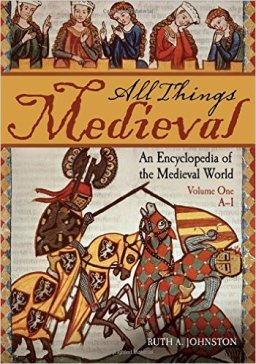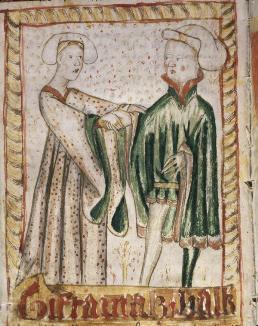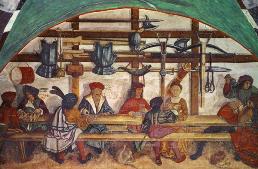The Dungeon Master’s Guide to the Middle Ages? (Review: All Things Medieval: An Encyclopedia of the Medieval World)

The horrible thing about being a historical novelist is that the specific information you need often exists, but not in an accessible form. You stand a good chance of being Embarrassingly Wrong on topics such as marriage customs for your particular setting and that — worse — you’ll discover this in your Amazon reviews: “I think you’ll find…”
That’s what drew me to All Things Medieval: An Encyclopedia of the Medieval World, a big fat pricey double volume by medievalist blogger Ruth A Johnston, “an independent scholar with a research specialty in medieval literature and languages” and published by the uber-respectable academic press Greenhill.
In the age of Wikipedia, it’s rather brave to publish any sort of popular encyclopedia, which is perhaps why this one seems priced for the academic and library market. It was of course the price — hefty for a hard copy, and perhaps outrageous for the ebook ($154.44 or £108.48!) — that nudged me into asking for review access. I needed to know: Is it any good for my research?
It’s certainly inspiring and well written; a worthy successor to books like the old A History of Everyday Things in England. Just glancing at the entries for M we have well-illustrated and lively topics: “Machines, Magic, Maps, Masons (See Stone and Masons), Measurement (See Weights and Measures), Medicine, Menageries (See Zoos), Mills, Minstrels and Troubadours, Monasteries, Monsters, Music, Muslims.”
There are, however, some curious omissions.
For example, in M we find no “Merchants.” When we dive over to T, there’s “Taverns and Inns” but no “Trade.” “E” gives us “Eyeglasses”, but no “Economics.” C tells us about “Carts” and “Coal”, but no “Commerce.” We have to content ourselves with the lovely long section for “Fairs” under “F.” From both a writer and an academic point of view, that’s a bit of a fail. (By way of contrast, both the academic reference works the Oxford Classical Dictionary and Late Antiquity: A Guide to the Postclassical World have big sections on “Commerce”.)
There are also things I would have liked to have seen from a modern reference work: travel and travel times; forms of address (when is a knight “My Lord” and a king, “Sir”?” — a maddening question for a writer); and Martial Arts (Medieval martial arts now being well-documented and proven to be socially and historically significant).
To balance this are — just for example — definitive entries on “Plague” and “Funerals”, and on “Marriage and “Monsters.” If it’s covered then it’s covered well enough that this is your one-stop reference work.
For example, here’s a snippet from “Taverns and Inns”:
Some taverns sold food, although many did not. When a tavern did sell food, the fare was likely to be simple and not likely to spoil, such as salted fish.Tavern keepers could also buy bread from a nearby bakery. Many taverns were prevented from cooking on the premises, since guild regulations did not include cooking. They could buy salted beef, bacon, pies, or other food from cookshops; customers could also buy from cookshops or street vendors and carry the snacks in. Cookshops sold small meat pies, often in trays carried by street criers…

This is readable. The author is clearly having immense fun wallowing in the era and at the same time understanding it. Here’s another snippet, this time from “Houses”:
When ceilings and walls had to be based on a length of wood, they could not exceed 15 or 16 feet at a stretch. The simplest house’s dimensions were the same as the available tree trunks and formed one room. Larger peasant houses could add a second room with another tree length, but the outer walls were always limited by the materials in this way.
Just wow.
This is a book you can read end-to-end for pleasure… which is why I grabbed myself the last cheap second hand copy on Amazon before submitting this review.
Is it worth the full price?
If you have a strong professional or hobby interest in the Middle Ages, then actually yes. This book will probably save you time and money because you won’t need all those funny little volumes on private life and seasons and agriculture and inns…. Really it’s just the price of half a dozen impulse purchases.
However, the ebook will do you just as well as the hardcopy; the illustrations are nice, but really just nice-to-have. The resolution on your Kindle will be fine and if you need a better resolution, then it’s probably online somewhere.
It’s certainly a book you won’t regret having. This review took me an afternoon to write because I kept falling into rabbit holes… Did you know that Northern European towns like London and Paris started paving some of their streets in the 12th century? The workmen would sit on three-legged stools and pound the bricks or rocks into the dirt. And did you also know that bridges were…
And I’ll stop there.
If All Things Medieval: An Encyclopedia of the Medieval World is not quite the Dungeon Master’s Guide to the Middle Ages, it almost is. I look forward to having it to hand in my writing den.
M Harold Page is the sword-wielding author of works such as Swords vs Tanks (Charles Stross: “Holy ****!”). For his take on writing, read Storyteller Tools: Outline from vision to finished novel without losing the magic. (Ken MacLeod: “…very useful in getting from ideas etc to plot and story.” Hannu Rajaniemi: “…find myself to coming back to [this] book in the early stages.”)

Wait, is “Marriage and Monsters” a single entry? I’m riffling through my mental catalogue of Loathly Lady tale variations and trying to figure out if there are enough of them to justify an entry on them separate from a more general entry on “Marriage.”
Now I’m imagining “Marriage & Monsters” as a second- or third-tier RPG published in the 1980s and reviewed in Dragon.
Now I’m forced to leave the typo in!
For those who missed the link, you can check out the author’s medievalist blog here: http://ruthjohnston.com/AllThingsMedieval/
She doesn’t seem to have any academic credentials, but she does seem meticulous and well informed.
I love your review! As the author, just a few comments and answers:
the reason there aren’t entries on trade or commerce, or merchants for that matter, is that Greenwood Press had specifications for a book in this “All Things” series. Normally, they target an author: All Things Chaucer, All Things Austen. They asked me to target a time period, but using the same specs. So many entries, such and such length, can’t group certain things, must group others. All must be concrete “things.”
Normally, the writer derives a list of entries by starting with the books: all the works of Austen, say, with the types of carriages or food indexed. The entries are drawn from this master list, with attention to including all of the “things.” But I was drawing from a time period, which was a different kettle of fish.
I included categories of people when they had their own set of “things,” like knights, minstrels, Jews and Muslims. Whenever the people could be found in an entry on a “thing,” that’s what the editor preferred. Certainly no processes or ideas! I chose to be a bit broad in my categories so that I could include letters and numbers, or various raw materials like water and metal.
“She doesn’t seem to have any academic credentials, but she does seem meticulous and well informed.” That will be my epitaph, with one additional phrase: “easy to read.” Or perhaps my favorite comment about A Companion to Beowulf, which I liked so much I put it on the back cover of the paperback I issued myself (Greenwood doesn’t do paperbacks): “It wears its learning lightly.”
The blogging I do isn’t real blogging, it’s really more about using Facebook as an informal history magazine for friends. I collect what I write for Facebook in a WordPress blog. Because it’s written for busy friends, the entries always wear their learning lightly. I do my best not to be positively wrong, and as every writer knows, that’s a pretty high standard.
Thanks for buying, reading, and discussing!
So nice that you read my review! What you say makes perfect sense and your book continues to be my goto for all things medieval.
I hope you will write a follow up work that’s more of a “dungeon masters guide” as in an era of the period as seen from the point of view of merchants, travellers, mercenaries, itinerant knights, pilgrims and other adventurers.
(If you are still active on Facebook, I’m Martin Page. It’ll be fairly clear which one I am, because sword…)